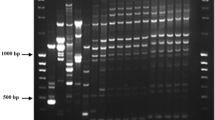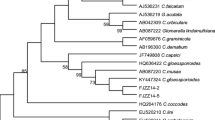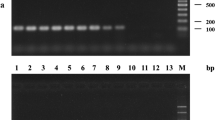Abstract
Several species of Botryosphaeriaceae and Phaeomoniella chlamydospora are common agents of grapevine decline worldwide. Currently, the use of culture independent PCR based techniques for detection of Botryosphaeriaceae within grapevine tissues has been limited to Botryosphaeria dothidea. In the present study, two Botryosphaeriaceae specific nested PCR assays were developed. One with a narrow target range, to detect Neofusicoccum parvum and the closely related species complex (Neofusicoccum parvum/N. ribis sensu Pavlic et al. Molecular Phylogenetics and Evolution 51:259–268, 2009) and another, with a wider range, to detect all 17 species of Botryosphaeriaceae which have been reported as potential wood pathogens of grapevine. The effectiveness of these assays was validated in vivo on naturally infected wood samples collected from standing vines and dormant grafted rooted cuttings commercialized in Italy by different nurseries in different years. All samples were also screened by means of a previously published nested PCR assay specific for Phaeomoniella chlamydospora. It was found that: 1) propagation material may play an important role as source of primary inoculum, not only of Phaeomoniella chlamydospora, as previously reported, but also for members of the Botryosphaeriaceae, among which Neofusicoccum parvum, Botryosphaeria dothidea and Diplodia seriata are the most common, and 2) multiple infections by different species belonging to Botryosphaeriaceae and/or Phaeomoniella chlamydospora occur frequently both in standing vines and propagation material. This last finding supports the hypothesis that at least some of the non-specific symptoms of grapevine decline may be due to the presence of different pathogens within host tissues.





Similar content being viewed by others
References
Alves, A., Phillips, A. J. L., Henriques, I., & Correia, A. (2007). Rapid differentiation of species of Botryosphaeriaceae by PCR fingerprinting. Research in Microbiology, 158, 112–121. doi:10.1016/j.resmic.2006.10.003.
Andolfi, A., Cimmino, A., Evidente, A., Iannaccone, M., Capparelli, R., Mugnai, L., et al. (2009). A new flow cytometry technique to identify Phaeomoniella chlamydospora exopolysaccharides and study mechanisms of esca grapevine foliar symptoms. Plant Disease, 93, 680–684. doi:10.1094/PDIS-93-7-0685.
Aroca, A., García-Figueres, F., Bracamonte, L., Luque, J., & Raposo, R. (2006). A survey of trunk disease pathogens within rootstocks of grapevines in Spain. European Journal of Plant Pathology, 115, 195–202. doi:10.1007/s10658-006-9008-5.
Aroca, A., Gramaje, D., Armengol, J., García-Jiménez, J., & Raposo, R. (2010). Evaluation of the grapevine nursery propagation process as a source of Phaeoacremonium spp. and Phaeomoniella chlamydospora and occurrence of trunk disease pathogens in rootstock mother vines in Spain. European Journal of Plant Pathology, 126, 165–174. doi:10.1007/s10658-009-9530-3.
Carlucci, A., Lops, F., Raimondo, M. L., Gentile, V., Mucci, M., & Frisullo, S. (2009). The Botryosphaeria species from vineyards of Apulia. Phytopathologia Mediterranea, 48, 180.
Cristinzio, G. (1978). Gravi attacchi di Botryosphaeria obtusa su vite in provincia di Insernia. Informatore Fitopatologico, 6, 21–23.
Crous, P. W., & Gams, W. (2000). Phaeomoniella chlamydospora gen. et. comb. nov., the causal organism of Petri grapevine decline and esca. Phytopathologia Mediterranea, 39, 112–118.
Crous, P. W., Phillips, A. J. L., & Baxter, A. P. (2000). Phytopathogenic fungi from South Africa. Stellenbosch, South Africa: University of Stellenbosch Printers, Department of Plant Pathology Press, p 358.
Crous, P. W., Slippers, B., Wingfield, M. J., Rheeder, J., Marasas, W. F. O., Phillips, A. J. L., et al. (2006). Phylogenetic lineages in the Botryosphaeriaceae. Studies in Mycology, 55, 235–253.
Damm, U., Crous, P. W., & Fourie, P. H. (2007). Botryosphaeriaceae as potential pathogens of Prunus species in South Africa, with descriptions of Diplodia africana and Lasiodiplodia plurivora sp. nov. Mycologia, 99, 664–680. doi:10.3852/mycologia.99.5.664.
Edwards, J., Constable, F., Wiechel, T., & Salib, S. (2007). Comparison of the molecular tests-single PCR, nested PCR and quantitative PCR (SYBR®Green and TaqMan®) for detection of Phaeomoniella chlamydospora during grapevine nursery propagation. Phytopathologia Mediterranea, 46, 58–72.
Evidente, A., Punzo, B., Andolfi, A., Cimmino, A., Melck, D., & Luque, J. (2010). Lipophilic phytotoxins produced by Neofusicoccum parvum, a grapevine canker agent. Phytopathologia Mediterranea, 49, 074–079.
Huelsenbeck, J. P., & Ronquist, F. (2001). MRBAYES: Bayesian inference of phylogenetic trees. Bioinformatics, 17, 754–755. doi:10.1093/bioinformatics/17.8.754.
Larignon, P., Fulchic, R., Cere, L., & Dubos, B. (2001). Observation on black dead arm in French vineyards. Phytopathologia Mediterranea, 40, S336–S342.
Luque, J., Martos, S., & Phillips, A. J. L. (2005). Botryosphaeria viticola sp. nov. on grapevines: a new species with Dothiorella anamorph. Mycologia, 97, 1111–1121. doi:10.3852/mycologia.97.5.1111.
Martin, M. T., & Cobos, R. (2007). Identification of fungi associated with grapevine decline in Castilla y León (Spain). Phytopatologia Mediterranea, 46, 18–25.
Martos, S., Andolfi, A., Luque, J., Mugnai, L., Surico, G., & Evidente, A. (2008). Production of phytotoxic metabolites by five species of Botryosphaeriaceae causing decline on grapevines, with special interest in the species Neofusicoccum luteum and N. parvum. European Journal of Plant Pathology, 121, 451–461. doi:10.1007/s10658-007-9263-0.
Martos, S., Torres, E., Garcia, F., & Luque, J. (2009). Detection of Botryosphaeriaceae species occurring on grapevines in Spain by cooperational PCR coupled with dot blot hybridization. Phytopathologia Mediterranea, 48, 162.
Pascoe, I. (1998). Trunk diseases of grapevines—perspectives from a tour of California. The Australian Grapegrower & Winemaker, 417, 68–71.
Pavlic, D., Slippers, B., Coutinho, T. A., & Wingfield, M. J. (2009). Multiple gene genealogies and phenotypic data reveal cryptic species of the Botryosphaeriaceae: a case of study on the Neofusicoccum parvum/N. ribis complex. Molecular Phylogenetics and Evolution, 51, 259–268. doi:10.1016/j.ympev.2008.12.017.
Phillips, A. J. L. (2002). Botryosphaeria species associated with diseases of grapevines in Portugal. Phytopathologia Mediterranea, 41, 3–18.
Retief, E., McLeod, A., & Fourie, P. H. (2006). Potential inoculum sources of Phaeomoniella chlamydospora in South African grapevine nursery. European Journal of Plant Pathology, 115, 331–339. doi:10.1007/s10658-006-9025-4.
Rolshausen, P. E., Úrbez-Torres, J. R., Rooney-Latham, S., Eskalen, A., Smith, R. J., & Gubler, W. D. (2010). Evaluation of pruning wound susceptibility and protection against fungi associated with grapevine trunk diseases. American Journal of Enology and Viticulture, 61, 113–119.
Romanazzi, G., Murolo, S., Pizzichini, L., & Nardi, S. (2009). Esca in young and mature vineyards, and molecular diagnosis of the associated fungi. European Journal of Plant Pathology, 125, 277–290. doi:10.1007/s10658-009-9481-8.
Slippers, B., Crous, P. W., Denman, S., Countinho, T. A., Wingfield, B. D., & Wingfield, M. J. (2004). Combined multiple gene genealogies and phenotypic character differentiate several species previously identified as Botryosphaeria dothidea. Mycologia, 96, 83–101.
Sparapano, L., Bruno, G., & Graniti, A. (2000). Effects on plants of metabolites in culture by Phaeocremonium chlamydospora, P.aleophilum and Fomitiporia punctata. Phytopathologia Mediterranea, 39, S169–S177.
Surico, G. (2009). Towards a redefinition of the diseases within the esca complex of grapevine. Phytopathologia Mediterranea, 48, 5.
Surico, G., Mugnai, L., & Marchi, G. (2006). Older and more recent observations on esca: a critical overview. Phytopathologia Mediterranea, 45, S68–S86.
Swofford, D. L. (2002). PAUP*. Phylogenetic analysis using parsimony (*and other methods), version 4.0b10 (Alvitec). Sunderland: Sinauer.
Tamura, K., Dudley, J., Nei, M., & Kumar, S. (2007). MEGA4: molecular evolutionary genetics analysis (MEGA) software version 4.0. Molecular Biology and Evolution, 24, 1596–1599. doi:10.1093/molbev/msm092.
Tegli, S., Bertelli, E., & Surico, G. (2000). Sequence analysis of ITS ribosomal DNA in five Phaeoacremonium species and development of a PCR-based assay for the detection of P. chlamydosporum and P. aleophilum in grapevine tissue. Phytopathologia Mediterranea, 39, 134–149.
Tuite, J. (1969). Plant pathological methods-fungi and bacteria. Minneapolis: Burgess.
Úrbez-Torres, J. R., & Gubler, W. D. (2009). Pathogenicity and epidemiology of Botryosphaeriaceae from grapevines in California. Plant Disease, 93, 584–592. doi:10.1094/PDIS-93-6-0584.
Úrbez-Torres, J. R., Leavitt, G. M., Voegel, T. M., & Gubler, W. D. (2006). Identification and distribution of Botryosphaeria spp. associated with grapevine cankers in California. Plant Disease, 90, 1490–1503. doi:10.1094/PD-90-1490.
van Niekerk, J. M., Crous, P. W., Groenewald, J. Z., Fourie, P. H., & Halleen, F. (2004). DNA phylogeny, morphology and pathogenicity of Botryosphaeria species on grapevines. Mycologia, 96, 781–798.
van Niekerk, J. M., Fourie, P. H., Halleen, F., & Crous, P. W. (2006). Botryosphaeria spp. as grapevine trunk disease pathogens. Phytopathologia Mediterranea, 45, S43–S54.
White, T. J., Bruns, T., Lee, S., & Taylor, J. (1990). Amplification and direct sequencing of fungal ribosomal RNA genes for phylogenetics. In M. A. Innis, D. H. Gelfand, J. J. Sninsky, & T. J. White (Eds.), PCR protocols, a guide to methods and applications (pp. 315–322). San Diego: Academic.
Acknowledgements
This research was commissioned from ARSIA-Toscana (Regional Agency for Development and Innovation in Agriculture and Forestry) by fourteen administrative Regions and autonomous provinces and financed with funds provided by the Ministero per le Politiche Agricole e Forestali (Ministry for Agricultural and Forestry Policy) to implement the inter-Regional Project “Grapevine esca: research and experiment in the nursery and in the field for prevention and cure”. Thanks are due to all nurseries and the Stazione Sperimentale per la Viticoltura Sostenibile S.r.l. of Gaiole in Chianti (Siena, Italy) for providing the propagation material that was used in this work, and the WWF of the Burano Lake Conservation Area (Grosseto, Italy) for allowing us to sample V.vinifera subsp. sylvestris plants. A. Phillips was financed by grant number SFRH/BCC/15810/2006 from Fundação para a Ciência e a Tecnologia (FCT) Portugal and project number PPCDT/AGR/56140/2004 from FCT. Prof. Marlene Jaspers, Dr. Jordi Luque, Prof. Sandra Savocchia and Dr. José Ramón Úrbez-Torres provided many of the fungal strains.
Author information
Authors and Affiliations
Corresponding author
Rights and permissions
About this article
Cite this article
Spagnolo, A., Marchi, G., Peduto, F. et al. Detection of Botryosphaeriaceae species within grapevine woody tissues by nested PCR, with particular emphasis on the Neofusicoccum parvum/N. ribis complex. Eur J Plant Pathol 129, 485–500 (2011). https://doi.org/10.1007/s10658-010-9715-9
Accepted:
Published:
Issue Date:
DOI: https://doi.org/10.1007/s10658-010-9715-9




